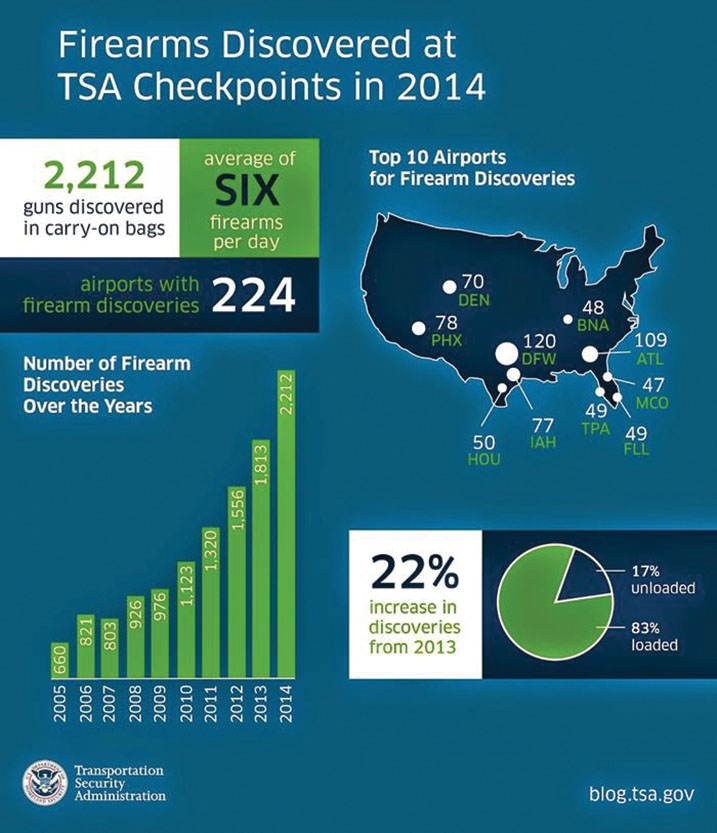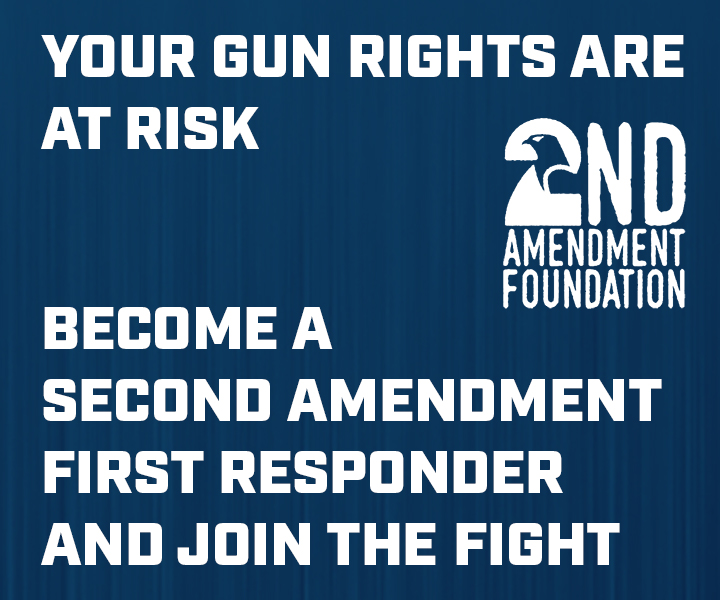by Debbie Caruana
Did you know that in 2014, 2,212 firearms were discovered in carry-on bags at airport checkpoints across the country, averaging more than six firearms per day? Of those, 1,835 (83%) were loaded. One example is a 94-year-old man who went to the checkpoint at LaGuardia Airport in New York with a loaded revolver clipped to his belt. Another is a woman who packed quickly and said that a gun that had been missing in her family for many years was found by TSA in her carry-on bag at the airport when she was checking in. And it too was loaded. This could be a very costly mistake.
In case you are wondering how things like this keep happening, the TSA says that most of the time, passengers just forget about the guns they carry regularly. This makes some sense. If you live in a place where you can carry a concealed weapon, you are probably used to having it with you at all times. See? It could happen to anyone, right?
In U.S. Code: Title 18- Part 1- Chapter 44- § 921, the term “firearm” means (A) any weapon (including a starter gun) which will or is designed to or may readily be converted to expel a projectile by the action of an explosive; (B) the frame or receiver of any such weapon.
Federal law does not prohibit transportation of legally acquired firearms across state lines for lawful purposes, unless the individual transporting the firearms is explicitly prohibited from owning/possessing any firearm. If you are not sure if you fall under any prohibited category, you should consult an attorney prior to travel.
 There is no federal permit available or required for the interstate transport of firearms. However, many states and localities have laws governing the possession of firearms as well as their transportation.
There is no federal permit available or required for the interstate transport of firearms. However, many states and localities have laws governing the possession of firearms as well as their transportation.
Generally, travelers should transport firearms unloaded in a locked, hard-sided container, in a separate area from any passenger area and not visible to any outside parties, i.e. if in a car, the locked box should be in the trunk of the car, not in the glove compartment or an internal console. If no trunk is available a separate tool box outside of the passenger compartment would be advisable. Ammunition should always be in a separate locked container. You should also be aware of local firearms regulations for your destination as well as any area you may decide to drive through, stop, stay over, or delay your travel for any reason.
If traveling by airplane, or other public transportation, other firearms regulations will come into play. The TSA has its own regulations for airline travel, and each airline may also have their own regulations, as well as state, local and international governments. If planning to bring your firearm with you when traveling by airplane, refer to the TSA Regulations, as well as the individual airline regulations and state and local laws for your destination as well as any stop-over locations, and print a copy to bring with you to the airport in case a discrepancy arises. All firearms must be unloaded (including the chamber, magazine or cylinder) and in a hard-sided, locked container, in checked luggage when travelling on an airplane.
Check with the airline to determine how to carry ammunition, and the amounts and types of ammunition that would be allowed. Ammunition must also be in checked luggage, in the manufacturer’s packaging or in a fiber or metal box specifically designed to carry ammunition, and may or may not be able to be placed into the same hard-sided container as the firearm, depending on the airline you are using. No firearms, ammunition, or parts of firearms, i.e. frames, receivers, or suppressors, clips and magazines; or any other destructive device, are permitted in carry-on luggage. Even realistic replicas and starting pistols are prohibited from carry-on luggage. You may pack a rifle scope in either carry-on or checked luggage.
If you are a firearm owner, you should always check your baggage carefully before packing it for a trip on an airplane, even if you are not intending to bring your firearm with you, especially if your baggage may have been used as a range bag or storage for your defensive firearm at home or business. All firearms and ammunition, and firearms parts, must be declared either orally or in writing, depending on the airline carrier’s regulations. All firearms must be unloaded. Severe civil and/or criminal penalties may be sanctioned for inadvertently failing to declare a firearm in checked luggage, or included in carry-on luggage, whether intended or not, which could result in fines up to $11,000 dollars, and criminal charges which could include jail time, not to mention attorney fees, and the possible loss of your firearm. All because you never checked that outside pocket of the bag you decided to use for your trip.
When arriving at an airport for check-in to a flight, do not deviate from going directly to the inside check-in counter and declaring your firearms to the airline agent. Also, all checked luggage is subject to inspection, so you should stay near your gate and pay particular attention to announcements that may require your presence to open your locked firearms case for inspection by TSA members. Also, have any licenses and permits available and ready for inspection. Be familiar with all jurisdictional firearms laws for all destinations and transfer points, and have printed copies of the actual regulations handy if necessary.
If travelling in or through New York City, you should probably leave your firearms at home or ship them to your destination, unless you have a New York City handgun license or special permit. All New York City and New Jersey airports have highly restrictive regulations on transportation of firearms, and law enforcement sometimes goes to extreme measures to prosecute anyone travelling through with firearms, even if they are fully compliant with federal regulations. Shipping your firearms ahead of time would save you a lot of hassle in these airports.
Amtrak also has regulations for transporting firearms on its trains. First, notification by passengers checking firearms must be made no later than 24 hour before departure by calling them on the phone at 800-USA-RAIL. Online reservations for firearms/ammunition are not accepted. Also, the passenger must travel on the same train that is transporting the checked firearm. All firearms must be unloaded, in an approved hard-sided locked container, of which they also specify size and weight limits not exceeding 62” L x 17” W x 7” D (1575 mm x 432 mm x 178 mm,) and 50 lbs/23 kg. If the container is small enough it can be put into checked luggage, but must be declared in any case. Transporting ammunition is similar to that of the airlines, and must be in a box or manufacturer’s carton or other container specifically designed to carry ammunition, but there is also a weight limit for ammunition transported on trains, not to exceed 11 lbs. or 5 kg. The passenger who checks a firearm with Amtrak is also responsible for knowing and following all federal, state, and local firearms laws at all jurisdictions to and through which he or she will be travelling, and checked baggage must be available on all trains and in all stations on the passenger’s itinerary since firearms are never allowed in carry-on luggage.
As for Greyhound Bus Lines, firearms are strictly prohibited, and, generally, firearms are not permitted on board public transport vehicles, either.
International travel is another thing altogether. If traveling outside of the US and you wish to bring your firearm, you will need to contact and follow all of the regulations for the form of travel you are using, as well as the country or countries you plan on visiting. Best to do some homework on the country and if you are even allowed to bring your firearm first. It is entirely possible that, although you are welcome to visit that country, your firearm is not.
Good Travels!
CAUTION: Federal and state firearms laws are subject to frequent change. This summary is not to be considered as legal advice or a restatement of law. To determine the applicability of these laws to specific situations which you may encounter, you are strongly urged to consult a local attorney.



